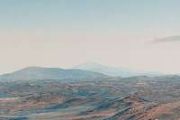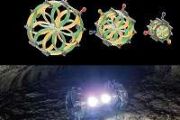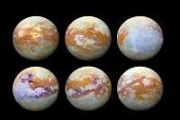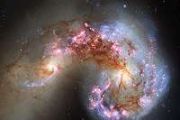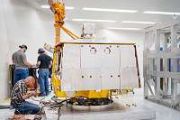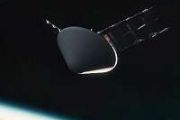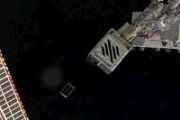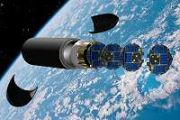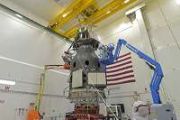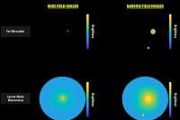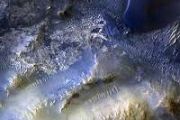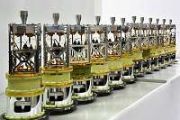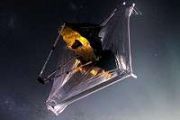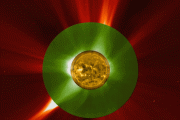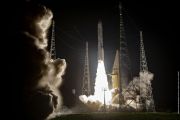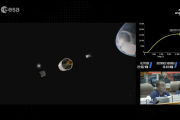
Copernical Team
Sols 3614-3615: Chemin's Moment To Shine
 The Curiosity team continues with our "Canaima" drill campaign. [Today's] 2-sol plan will provide our first look at the minerals present within this sample. This is complementary but different than the chemical compositions provided by ChemCam and APXS before we drilled. CheMin uses X-ray diffraction to confirm crystalline mineralogy, they direct a beam of X-rays, as fine as a human hair, throug
The Curiosity team continues with our "Canaima" drill campaign. [Today's] 2-sol plan will provide our first look at the minerals present within this sample. This is complementary but different than the chemical compositions provided by ChemCam and APXS before we drilled. CheMin uses X-ray diffraction to confirm crystalline mineralogy, they direct a beam of X-rays, as fine as a human hair, throug Tiangong space station marks key step in assembly
 The Wentian lab module of China's Tiangong space station has been repositioned to dock with a radial port on the station's Tianhe core module on Friday afternoon, which marked a key step in Tiangong's in-orbit assembly, according to the China Manned Space Agency.
The agency said in a news release that during the hour-long operation that finished at 12:44 pm, Wentian was moved from the axia
The Wentian lab module of China's Tiangong space station has been repositioned to dock with a radial port on the station's Tianhe core module on Friday afternoon, which marked a key step in Tiangong's in-orbit assembly, according to the China Manned Space Agency.
The agency said in a news release that during the hour-long operation that finished at 12:44 pm, Wentian was moved from the axia Ad-block this: Advertisers ready to hit you with commercials from space
 Researchers from Skoltech and MIPT have studied the economic feasibility of a space advertising mission that would launch a formation of satellites into orbit to reflect sunlight and display commercials in the sky above cities. Published in the journal Aerospace, the study considers such factors as satellite fuel consumption, target city population, local advertising costs, and many more, arrivi
Researchers from Skoltech and MIPT have studied the economic feasibility of a space advertising mission that would launch a formation of satellites into orbit to reflect sunlight and display commercials in the sky above cities. Published in the journal Aerospace, the study considers such factors as satellite fuel consumption, target city population, local advertising costs, and many more, arrivi Virgin Orbit's next rocket ready for Cornwall
 Virgin Orbit (Nasdaq: VORB), a leading responsive launch provider, reports that its latest rocket has completed a full launch rehearsal and is now ready for flight. The window for the company's next launch, planned to be the first orbital space launch from the U.K., will be determined by the launch permitting regulatory process.
This rehearsal marked the final major acceptance test of the
Virgin Orbit (Nasdaq: VORB), a leading responsive launch provider, reports that its latest rocket has completed a full launch rehearsal and is now ready for flight. The window for the company's next launch, planned to be the first orbital space launch from the U.K., will be determined by the launch permitting regulatory process.
This rehearsal marked the final major acceptance test of the Swedish space instrument will study the Moon on board a Turkish spacecraft
 A space instrument from the Swedish Institute of Space Physics (IRF) will be sent to the Moon within the next few years onboard the Turkish spacecraft AYAP-1. In orbit around the Moon, the Lunar Neutrals Telescope will study how the flow of charged particles from the Sun, the solar wind, interacts with the Moon's surface.
The agreement between IRF and the Turkish Space Technologies Researc
A space instrument from the Swedish Institute of Space Physics (IRF) will be sent to the Moon within the next few years onboard the Turkish spacecraft AYAP-1. In orbit around the Moon, the Lunar Neutrals Telescope will study how the flow of charged particles from the Sun, the solar wind, interacts with the Moon's surface.
The agreement between IRF and the Turkish Space Technologies Researc SpaceX's Crew 5 mission blasts off to ISS with Russian cosmonaut onboard
 NASA and SpaceX's Crew 5 mission lifted off from Cape Canaveral Space Force Station in Florida at noon EDT on Wednesday and is on its way to the International Space Station.
The crew, which includes NASA astronauts Nicole Mann and Josh Cassada, Japanese astronaut Koichi Wakata and Russian cosmonaut Anna Kikina, are scheduled to work aboard the space station for six months.
SpaceX
NASA and SpaceX's Crew 5 mission lifted off from Cape Canaveral Space Force Station in Florida at noon EDT on Wednesday and is on its way to the International Space Station.
The crew, which includes NASA astronauts Nicole Mann and Josh Cassada, Japanese astronaut Koichi Wakata and Russian cosmonaut Anna Kikina, are scheduled to work aboard the space station for six months.
SpaceX Overlapping galaxies VV 191 (Webb and Hubble composite image)
 Image:
Overlapping galaxies VV 191 (Webb and Hubble composite image)
Image:
Overlapping galaxies VV 191 (Webb and Hubble composite image) Eight steps to advance ESA diversity

Diversity and inclusiveness are at the heart of the ESA’s values and are high on the ESA Agenda 2025 as key elements to complete the ESA Transformation. Eight steps, aimed at advancing these values as concrete initiatives, will pave the way for continuous improvement.
Juno gets highest-resolution close-up of Jupiter's moon Europa

Observations from the spacecraft's pass of the moon provided the first close-up in over two decades of this ocean world, resulting in remarkable imagery and unique science.
The highest-resolution photo NASA's Juno mission has ever taken of a specific portion of Jupiter's moon Europa reveals a detailed view of a puzzling region of the moon's heavily fractured icy crust.
The image covers about 93 miles (150 kilometers) by 125 miles (200 kilometers) of Europa's surface, revealing a region crisscrossed with a network of fine grooves and double ridges (pairs of long parallel lines indicating elevated features in the ice). Near the upper right of the image, as well as just to the right and below center, are dark stains possibly linked to something from below erupting onto the surface.
SpaceX's Crew 5 mission blasts off to International Space Station
 NASA and SpaceX's Crew 5 mission lifted off from Cape Canaveral Space Force Station in Florida at noon EDT on Wednesday and is on its way to the International Space Station.
The crew, which includes NASA astronauts Nicole Mann and Josh Cassada, Japanese astronaut Koichi Wakata and Russian cosmonaut Anna Kikina, are scheduled to work aboard the space station for six months.
SpaceX
NASA and SpaceX's Crew 5 mission lifted off from Cape Canaveral Space Force Station in Florida at noon EDT on Wednesday and is on its way to the International Space Station.
The crew, which includes NASA astronauts Nicole Mann and Josh Cassada, Japanese astronaut Koichi Wakata and Russian cosmonaut Anna Kikina, are scheduled to work aboard the space station for six months.
SpaceX 

